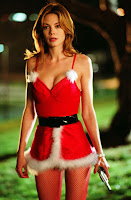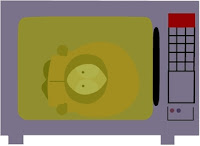Ahhh, Christmas. Time for family and friends. Eggnog and presents. Gathering around the fireplace and maybe watching a few holiday classics on the tube.
Also a great time for psychopaths, invading aliens, and big explosions.
I should probably explain that last bit.
Are you sitting comfortably?
Then we’ll begin.
In a way, holidays make for great settings because they come pre-packaged for a writer. Much in the same way saying “Angelina” conjures the mental image of a certain actress, I can tell you “the neighborhood is decorated for Christmas,” and I’ve set the stage. Just like that.
Oh, sure, I can go into more detail if I really need to. It might be very important that the Hendersons decorated that small pine on their front lawn and the Applebaums have mistletoe over their front door. And maybe that old Mister King has nothing on his lawn. But I’ve set out all the broad strokes with just six words. Even if the description never went any further, you know what Sawmill Drive or Sunset Boulevard look like. How many pages of writing does that save me?
Major holidays are great shorthand for the time of year and tone of a story. This can help you make the ideas behind your story even more powerful. Is there anything more romantic than meeting your true love on Valentine’s Day? We almost expect serial killers on Halloween. The 4th of July is just brimming with patriotism here in the U.S.
Y’know, it just struck me while writing that… How many countries have “Independence from England” as a national holiday? Dozens, right? And what’s England got? Guy Fawkes Day. They celebrate the day they didn’t let religious extremists take over.
Anyway…
If your setting lines up with your story, you’ve almost got a theme going there. If your characters are discussing peace on earth while decorating a Christmas tree, good for you. Maybe they’re talking about forgotten promises at New Year’s or being grateful at Thanksgiving. So if you’ve got a story that follows some holiday-centric ideas, it might be worth setting it at said holiday.
That being said there’s also a Clarke’s Law-type issue to consider here. Sometimes the best story to set at a given holiday is, in fact, the worst story for that holiday. For example…
If you’ve been reading this blog for any amount of time, you’ve probably heard me reference screenwriter Shane Black once or thrice. One of the things he’s known for is setting so many of his films at Christmas.  Lethal Weapon. The Long Kiss Goodnight. Kiss Kiss, Bang Bang. All fun movies, all set at Christmas. What’s interesting to note, though, is that not one of them depends on Christmas for any element of their story. Lethal Weapon is a buddy cop film about taking down drug lords. The Long Kiss Goodnight involves an AWOL assassin trying to stop her old employers. Heck, the most Christmassy part of Kiss Kiss, Bang Bang is Michelle Monaghan walking around for a good chunk of the film in her Naughty Santa costume.
Lethal Weapon. The Long Kiss Goodnight. Kiss Kiss, Bang Bang. All fun movies, all set at Christmas. What’s interesting to note, though, is that not one of them depends on Christmas for any element of their story. Lethal Weapon is a buddy cop film about taking down drug lords. The Long Kiss Goodnight involves an AWOL assassin trying to stop her old employers. Heck, the most Christmassy part of Kiss Kiss, Bang Bang is Michelle Monaghan walking around for a good chunk of the film in her Naughty Santa costume.
Christopher Moore’s wonderful book The Stupidest Angel is also set at Christmas. It’s got a zombie uprising during the most wonderful time of the year.
There’ve also been one or two Christmas horror movies, and a few Valentine’s Day ones as well. Again, reversing the expectations.
And how many alien invasions has the Doctor stopped on December 25th at this point? Five? Six?
Y’see, Timmy, what works for these films is the contrast between our expectations for this time of year and what the story delivers. Events become a little more extreme when played out against a backdrop that evokes opposing feelings. And if it’s a backdrop you don’t have to spend time describing or explaining… well, that just gives you time to get on with your story.
Next time we’ll be closing in on New Year’s, so I may chat about resolutions. Or looking forward to next year. Maybe both.
Until then, a very Happy Christmas season to you all. Don’t go too crazy with the eggnog– it is loaded with calories.
And go write.



